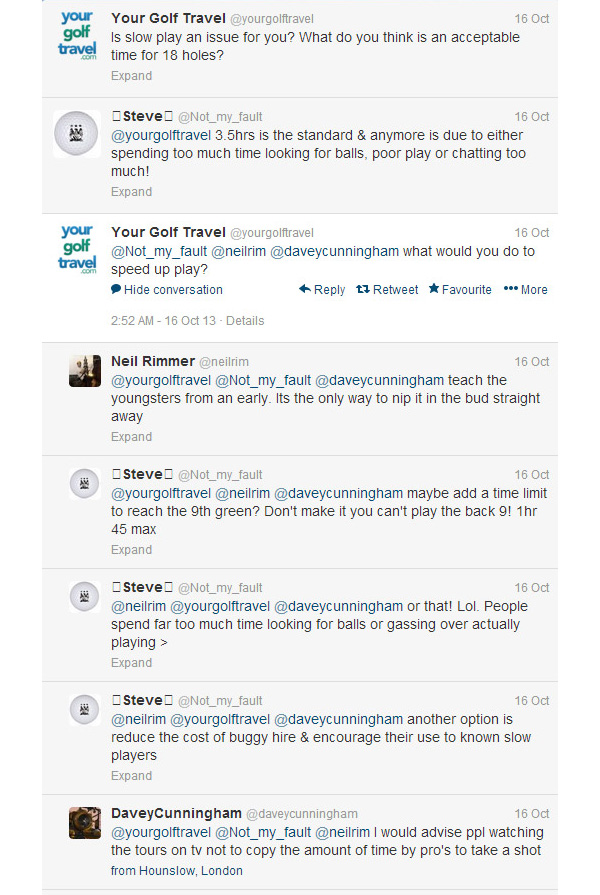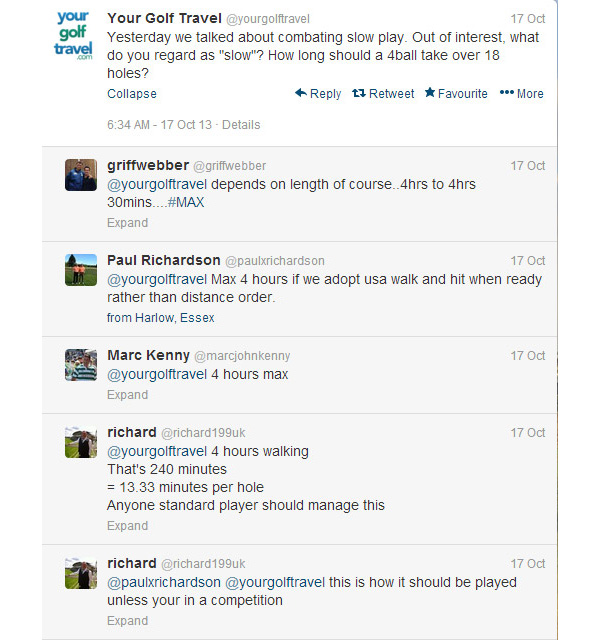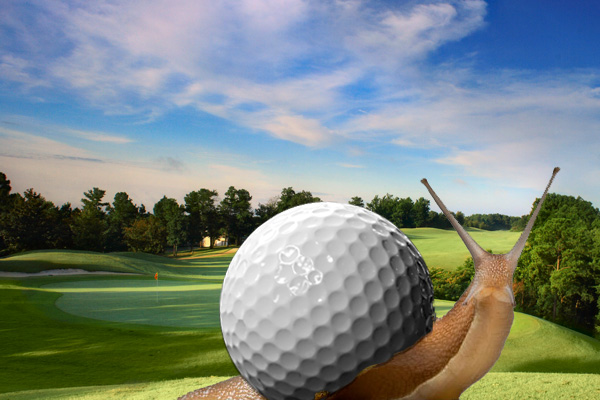“See those ducks? They were mere eggs at the beginning of today,” said CBS announcer Ben Wright during the final round of the 1983 Kemper Open. Slow play then, has long been an issue in the game of golf but in recent years, the problem seems to have gotten much, much worse.
Five and six hour rounds are now the norm on the PGA Tour and it’s not just on the professional tours that where slow play is causing problems; it’s perceived to be a problem at all levels of the game.
But how do you define “slow”?
While there are some who consider a four hour round to be about right for an everyday fourball, there are others who shudder at the thought of creeping around 18 holes in anything more than three hours…three and a half at the worst.

When we asked our Twitter followers how long a round of golf should take, less than four hours was a popular response. Above are more suggestions on how to speed things up on the course. Thanks to everyone who responded!
In my opinion the three hour brigade – golfers more interested in setting land speed records and getting back to the 19th hole – are just as much of a problem as the ones who take forever and a day to line up their putts, select the correct club in the fairway, or those who have a pre-shot routine more complicated than the protocol for launching nuclear weapons.
In fact, if you break down the numbers a little, you might realise just how unrealistic 3 hour rounds are for the average golfer.
A fourball playing 18 holes in three hours has just 10 minutes to complete each hole as well as arriving at the next one, ready to play. Should all four players achieve par on a par four for example, that timescale would mean each player has a little over half a minute to play each of their four shots to achieve par.
That’s also ignoring the fact that it takes time to walk between shots, rake bunkers, replace divots and so on and so forth. And what happens if someone loses a ball and spends a minute or two out of the five they’re entitled to looking for it before carrying on?
Apply the above maths to a four hour round (a little over 13 mins per hole) and you realise that even that is pretty swift for a fourball playing 18 holes.
What a lot of people seem to have forgotten is that golf is a difficult game and it takes time to play it…even on a good day! Also, a group of golfers can only play as fast as the group ahead of them and golfers in a group can only play as fast as the slowest player in that group.
Another problem is that the slow golfer doesn’t seem to realise that they are just that and they certainly don’t like to be told so. As we have previously said; different golfers have different opinions on what constitutes a slow round of golf and seeing as we can’t all agree, we thought we’d get some direction from Ben Groutage, the Senior Tournament Director for The Professional Golfers’ Association.
“Pace of play is usually around 4h 20m for three balls and 3h 50m for two balls. At Europro events, that is pretty standard,” said Groutage who went on to add that “Some of the newer courses we go to tend to have longer walks between greens and tees which pushes pace of play up too.”
There you have it. The PGA has guidelines for how long a round of golf on tour should take and if a group of three professional golfers are supposed to complete 18 holes in 4h 20m, how are a group of weekend warriors supposed to beat that pace?

Some of our Twitter followers have a more generous outlook on an acceptable pace of play.
It has to be said however that, while I have no issue with a four hour round of golf – after all I play golf because I enjoy it so what’s the rush? – there have been many instances over the years, on some courses more than others, where the 5 hour barrier comes into play and that is when the problem of slow play really does becomes a problem.
It is unreasonable to expect a group of golfers out for a leisurely stroll along the fairways to run in between shots to accommodate the quicker player – in most cases that’s the better player who might do well to appreciate that some golfers find the game tougher than others – just the same way that it’s unreasonable for the slower, let’s say more leisurely golfer, not to make way for the group behind who are being forced to wait on every tee and every fairway.
So what can be done to combat slow play?
Education seems to be the best place to start as, in a lot of cases, it seems like the modern golfer is not up to speed (excuse the pun) on how to make their way around a golf course efficiently, let alone how they should react to other, different paced groups out on the course.
In 2012, the PGA ran an education programme for all the members of the Europro Tour based around pace of play with the main focus on being ready to play when your turn comes. According to Ben Groutage, “this lead to a marked improvement in pace of play at Q School and is something the PGA will now do on an annual basis.”
Like in the professional game, in amateur golf a bit of education and common sense among golfers could improve things dramatically when it comes to pace of play so we thought we’d have a stab at outlining a few small things that could be done by golfers the world over in the interest of getting things moving a little quicker on the course.
1 – Play “Ready Golf”
If you’re ready to play while it’s someone else’s honour and they’re rooting through their bag looking for a tee, then whack away! If you’re waiting for someone else to play, then don’t just stand there willing them to hit their ball into the junk; be ready to play as soon as it’s your turn.

Simon Kelly, who follows Your Golf Travel on facebook, likes the idea of golfers playing ready golf where possible. Unless you’re playing in a competition or match, this is the way to go, especially when the course is busy!
2 – Leave your bag in a sensible spot
Leaving your bag in line with the next tee before you head off to putt out means you can evacuate the green as quickly as possible. There is little more annoying than waiting for a group to putt out only to spend the next 3 minutes collecting their belongings from the four points on the compass.
3 – Give Gimmes
This isn’t the Open Championship…If you’re playing casual golf with friends, don’t be mean. No matter how bad your friends might be, nobody is likely to miss that many putts from two feet! Plus it’s nice to get given putts yourself every now and again.
4 – Let faster players through at the earliest possible juncture
To save yourself from anyone “putting one up you” to hurry you along; why not just let quicker groups through as soon as you can? There is no shame in letting others through and at least this way you won’t have to worry about the guy back in the fairway with his hands on his hips, staring at you while you take a little time over a nervy four-footer for a par!
5 – Tee it Forward
Golfers have trouble selecting appropriate tees from which to play from according to their individual ability. OK so playing from the yellows rather than the championship tees might hurt the pride just a little, but if you score better and enjoy your round more, then what’s not to like? Don’t bit off more than you can chew!
6 – Play a Provisional
Next time your mate sprays one into the jungle from the tee and says, “Oh it’s OK…I’ll probably find it,” please insist on a provisional being played because, when you think of the size of a golf ball in relation to the space into which you’re hitting it then no, you probably won’t find it! Those who walk back to the tee after searching for a ball for 5 minutes should be severely punished!
7 – It’s just a golf ball!
Don’t become too attached to your golf balls. They are inanimate objects that don’t even like you to begin with. Why do you think they are always trying to escape!? If you last saw your ball flying into the trees at a right angle with the fairway, you probably won’t find it so a cursory glance on the way to your provisional (see suggestion 6!) will suffice. Also, if finding your ball means nothing to the outcome of your game, then don’t even bother looking…it’s just a golf ball!

When asked via the Your Golf Travel facebook page what can be done to speed up play on the golf course, William Stewart commented on golfers spending too much time looking for balls. We’re with you William!
8 – Pay attention to the Universal Laws of Golf
One of the Universal Rules of Golf which we all know to be true is that when most amateurs hit a shot that is making a beeline for trouble, they look down at the ground in disgust at the exact moment they should be looking at their ball if they ever want to see it again. If you insist on searching for golf balls, then at least try to make it easy on yourself!
Essentially, combatting slow play is the responsibility of the players who play the game and, quite simply, it all comes down to a bit of common sense here and a pinch of common courtesy there…it’s not rocket science! Next time you’re on the course remember; the little things that any golfer can do while on the course all count towards more efficient rounds of golf. Also, we all play the game of golf (I hope) because we enjoy it and while waiting around for others to get out of your way can be frustrating, life could be a lot worse than a few extra minutes being added to your time out on the course.





